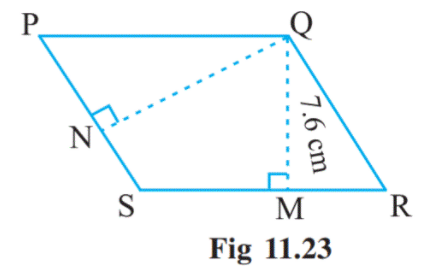PQRS is a parallelogram (Fig11.23).QM is the height from Q to SRandQN is the height from Q to PS. If SR=12cmandQM=8cm.
Find : (a) the area of the parallegram PQRS
(b) QN, if PS=8cm

Video Solution
Text Solution
It is given that
Height and QM = 7⋅6cm
SR as base = 12cm
We know that,
Area of parallelogram = Base×Height
SR×QM*
=12×7⋅6
Area of parallelogram = 91⋅2cm2
(ii)
We know that
Area of parallelogram = PS×QN*
91.2=8×QN*
QN=91.28×10*
QN=11.4 cm
|
Topper's Solved these Questions
Similar Questions
Knowledge Check
PQRS is a parallelogram in which PR is perpendicular to QS. If PR=8cm and QS=6 cm, then find PS
A5cmB4cmC7cmD6cmPQRS is a parallelogram in which PR is perpendicular to QS. If PR=8cm and QS=6 cm, then find PS
A5 cmB4 cmC7 cmD6 cmPQRS is a parallelogram. PX and QY are respectively, the perpendiculars from P and Q to SR and RS produced. then
APX=QYBSX=RYCBoth A and BDNone
Find the area of a parallelogram whose base is 8.5 cm and height 4 cm .
View SolutionOne of the sides and the corresponding height of a parallelogram are 4 cm and 3 cm respectively. Find the area of the parallelogram (Fig 11.17).
View SolutionTwo adjacent sides PS and RS of the parallelogram PQRS are 6 cm and 12 cm respectively. The height corresponding to the base RS is 5 cm. Find (i) the area of the parallelogram PQRS and (ii) the height corresponding to base PS.
View SolutionPQRS is a parallelogram. PS is produced to M, so that SM = SR and MR produced meets PQ produced at N. Prove that QN = QR.
View SolutionPQRS is an isosceles trapezium in which PS = 10 cm, PQ = SR = 13 cm and the distance between PS and QR is 12 cm. Find the area of the trapezium.
View Solution

